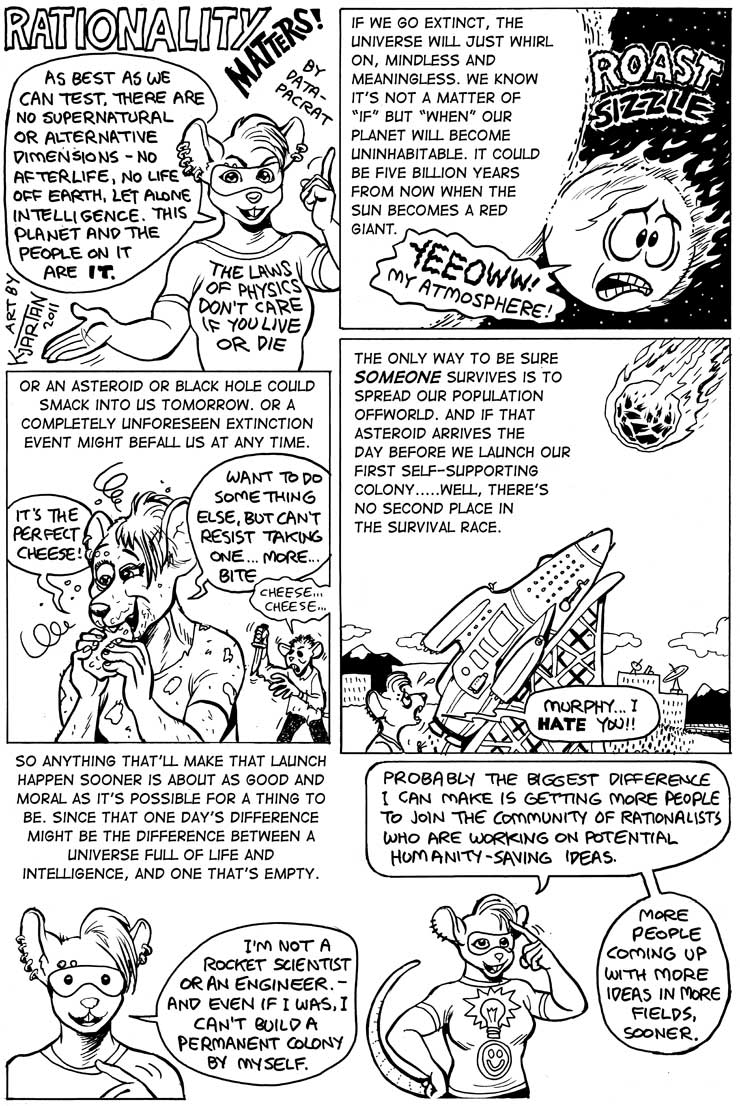May 23, 2013
Comic: Rationality Matters
Posted by DataPacRat in categories: education, existential risks, fun, humor




Medical science has changed humanity. It changed what it means to be human, what it means to live a human life. So many of us reading this (and at least one person writing it) owe their lives to medical advances, without which we would have died.
Live expectancy is now well over double what it was for the Medieval Briton, and knocking hard on triple’s door.
What for the future? Extreme life extension is no more inherently ridiculous than human flight or the ability to speak to a person on the other side of the world. Science isn’t magic – and ageing has proven to be a very knotty problem – but science has overcome knotty problems before.
A genuine way to eliminate or severely curtail the influence of ageing on the human body is not in any sense inherently ridiculous. It is, in practice, extremely difficult, but difficult has a tendency to fall before the march of progress. So let us consider what implications a true and seismic advance in this area would have on the nature of human life.
It’s not a physical landscape. It’s a term reserved for the new technologies. It’s a landscape in the future. It’s as though you used technology to take you off the ground and go like Alice through the looking glass.
John Cage, in reference to his 1939 Imagined Landscape [1].
In the last installment (see here, here and here) I argued that the increasing prominence and frequency of futuristic aesthetics and themes of empowerment-through-technology in EDM-based mainstream music videos, as well as the increasing predominance of EDM foundations in mainstream music over the past 3 years, helps promote general awareness of emerging-technology-grounded and NBIC-driven concepts, causes and potential-crises while simultaneously presenting a sexy and self-empowering vision of technology and the future to mainstream audiences. The only reason this is mentionable in the first place is the fact that these are mainstream artists and labels reaching very large audiences.
In this installment, I will be analyzing a number of music videos for tracks by “real EDM” artists, released by exclusively-EDM record labels, to show that these futuristic themes aren’t just a consequence of EDM’s adoption by mainstream music over the past few years, and that there is long history of futuristic aesthetics and gestalts in electronic music, as well as recurrent themes of self-empowerment through technology.
In this part I will discuss some of these recurrent themes, which can be seen to derive from a number of aspects shared by Virtual Art (any art created without the use of physical instruments), of which contemporary electronic music is an example because it is created using software. I argue that this will become the predominant means of art production — via software — for all artistic mediums, from auditory to visual to eventual olfactory, somatosensory and proprioceptual artistic mediums. The interface between artist and art will become progressively thinner and more transparent, culminating in a time where Brain-Computer-Interface technology can sense neural operation and translate this directly into an informational form to be played by physical systems (e.g. speakers) at first, but eventually into a form that can be read by given person’s own BCI instantiated phenomenologically via high-precision technological neuromodulation (of which deep brain stimulation is an early form).
Continue reading “Electronic Music as Emerging Tech. Embryo of Art's Entire Future — Part One” »
Tags: art, BCI, Cortese Franco, EDM, electronic music, futurism, human trajectories, media & arts, music
By Avi Roy, University of Buckingham
I want to live longer and help others do the same. I assumed the most effective way to do that is by understanding the science of aging and then engineering solutions to extend human lifespan. That is why I became a biomedical researcher and over the past several years I have pursued this goal almost single-mindedly.
When a 2004 study showed that reducing the calorie intake in mice extended their life by 42%, I enthusiastically embraced the results and even put myself on a calorie restricted diet. But, subsequently, a 2012 study showed that long-term calorie restriction may not have the promised benefits. On the contrary, fewer calories without the required nutrients might actually cause harm.
Calorie restriction is not the first such “promising” route that eventually did not live up to the promise, and it will not be the last. Antioxidants showed promise in holding back diseases caused by aging, but now we know that antioxidant supplements are more likely to shorten your life.
Tags: aging research, Antiaging., medicine
Asia Institute Report
Proposal for a Constitution of Information
March 3, 2013
Emanuel Pastreich
Introduction
Continue reading “"Proposal for a Constitution of Information" from the Asia Institute” »
Tags: constitution, Information, revolution
Congratulations Drs. Musha, Pinheiro & Valone on their soon to be published new book.
For those who are interested T. Musha, M.J. Pinheiro and T. Valone (Advanced Science Technology Research Organization, Yokohama, Japan, and others) have a new book that will be published soon:
Tags: Abraham force, advanced aviation systems, Advanced Science-Technology Research Organization, Biefeld-Brown, Einstein’s Unified Field Theory of Gravitation, electrogravity, electromagnetotoroid, gravitoelectromagnetic, Heim theory, M.J. Pinheiro, Magnus force, Novinka, quantum electrodynamics, T. Musha, T. Valone, zero point energy fluctuation
The Rocky Mountain chapter of the American Institute of Astronautics & Aeronautics (AIAA) will be having their 2nd Annual Technical Symposium, October 25 2013. The call for papers ends May 31 2013. I would recommend submitting your papers. This conference gives you the opportunity to put your work together in a cohesive manner, get feedback and keep your copyrights, before you write your final papers for journals you will submitting to. A great way to polish your papers.
Here is the link to the call for papers: http://www.iseti.us/pdf/RMAIAA_Call_For_Abstracts_2013-0507.pdf
Here is the link to the conference: http://www.iseti.us/pdf/RMAIAA_General_Advert_2013-0507.pdf
I’ll be presenting 2 papers. The first is a slightly revised version of the presentation I gave at the APS April 2013 conference here in Denver (http://www.iseti.us/WhitePapers/APS2013/Solomon-APS-April(20…45;15).pdf). The second is titled ‘The Mechanics of Gravity Modification’.
Tags: AIAA, An Introduction to Gravity Modification, Annual Technical Symposium, ATS, baking bread model, Bondi, Cloaking, Compressive Particles, Empirical Evidence Suggest A Need For A Different Gravitational Theory, Exotic Matter, garden rake, Gaussian, Gravity Wave Telescope, in String Theories, Inelastic Particles, Invisibility, Kenos, Laithwaite, Lorentz-Fitzgerald transformation, Milky Way, Near Field Gravity Probe, negative mass, Ni Field, Non-Locality, Perpetual Motion Machine, Podkletnov, quark interaction, RMAIAA, Shielding, spacetime continuum, Spatial Probability Field, Subspace, Supervectors, Tensile Particles, Transmission, Var-Gamma, wave function
As long as a recently published proof (European Scientific Journal March 2013 edition vol.9, No.9 ISSN: 1857–7881(Print) e-ISSN 1857–7431) remains unchallenged by the scientific community, this question is not only scientifically sound but also maximally important.
It would be great if this uncommon call for scientific assistance by imaginative readers across the world would find the resonance it deserves . Einstein would be delighted.
I have seen the future of Bitcoin, and it is bleak.
If you were to peek into my bedroom at night (please don’t), there’s a good chance you would see my wife sleeping soundly while I stare at the ceiling, running thought experiments about where Bitcoin is going. Like many other people, I have come to the conclusion that distributed currencies like Bitcoin are going to eventually be recognized as the most important technological innovation of the decade, if not the century. It seems clear to me that the rise of distributed currencies presents the biggest (and riskiest) investment opportunity I am likely to see in my lifetime; perhaps in a thousand lifetimes. It is critically important to understand where Bitcoin is going, and I am determined to do so.

The 2nd amendment of the American Constitution gives U.S citizens the constitutional right to bear arms. Perhaps the most prominent justification given for the 2nd amendment is as a defense against tyrannical government, where citizens have a method of defending themselves against a corrupt government, and of taking their government back by force if needed by forming a citizen militia. While other reasons are sometimes called upon, such as regular old individual self-defense and the ability for the citizenry to act as a citizen army in the event their government goes to war despite being undertrooped, these justifications are much less prominent than the defense-against-tyrannical-government argument is.
This may have been fine when the Amendment was first conceived, but considering the changing context of culture and its artifacts, might it be time to amend it? When it was adopted in 1751, the defensive-power afforded to the citizenry by owning guns was roughly on par with the defensive-power available to government. In 1751 the most popular weapon was the musket, which was limited to 4 shots per minute, and had to be re-loaded manually. The state-of-the-art for “arms” in 1791 was roughly equal for both citizenry and military. This was before automatic weapons – never mind tanks, GPS, unmanned drones, and the like. In 1791, the only thing that distinguished the defensive or offensive capability of military from citizenry was quantity. Now it’s quality.
